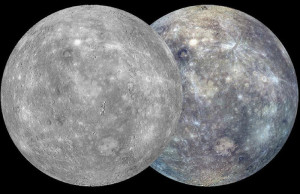Peter Lobner
Updated 12 January 2016
The 1,069 pound Messenger (MErcury Surface, Space ENvironment, GEochemistry, and Ranging) spacecraft is only the second spacecraft sent to Mercury. Mariner 10 flew past Mercury three times in 1974 and 1975. Messenger was launched on 3 August 2004 and flew for 6-1/2 years on a circuitous trajectory that included 15 orbits of the sun, one flyby of Earth, two flybys of Venus, and three flybys of Mercury before entering orbit around Mercury in 18 March 2011. The series of planetary flybys allowed Messenger to decelerate relative to Mercury and achieve orbit with minimal use of fuel.
The NASA Messenger mission website is at the following link:
http://www.nasa.gov/mission_pages/messenger/main/index.html
Messenger is solar-powered, with its science payload and propulsion system located behind a sunshade to protect against the intense solar radiation encountered at Mercury’s close orbit of the Sun.
 Source: Johns Hopkins University/APL
Source: Johns Hopkins University/APL
Messenger has instrumentation for mapping and characterizing Mercury using imaging cameras, laser altimeter, various spectrometers, magnetometer, and a radio science package to measure slight velocity changes in orbit. You can read details on the spacecraft instrumentation systems at the following link:
http://messenger.jhuapl.edu/the_mission/spacecraft_design.html
After four years in orbit, fuel needed to maintain orbit is expected to be depleted in April. Messenger’s orbit will decay and the spacecraft eventually will crash at perigee into Mercury’s surface at its orbital speed of 8,750 mph.
12 January 2016 update:
On 30 April 2015, Messenger crashed into the surface of Mercury on the side facing away from Earth. Before crashing, Messenger orbited Mercury 4,105 times and collected more than 277,000 images. A composite photograph of Mercury created from thousands of Messenger images is shown below:
